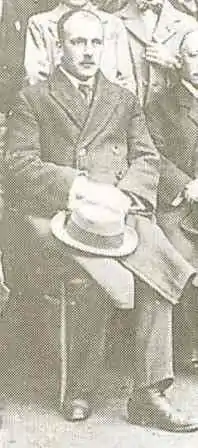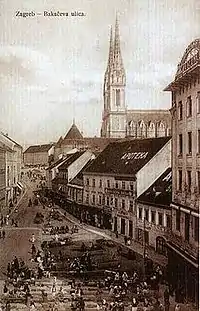Vjekoslav Bastl
Vjekoslav "Alojz" Bastl (1872–1947) was a Croatian architect known for his diverse secessionist architectural style. His work circulated mostly within the boundaries of Zagreb, where he resided. Later in life, he got heavily influenced by modernism. Today, he is regarded as one of the highlights of early modern architecture in Croatia.
Vjekoslav Bastl | |
|---|---|
 | |
| Born | August 13, 1872 |
| Died | September 3, 1947 (aged 75) |
| Nationality | Croatian |
| Occupation | Architect |
| Practice | Hönigsberg & Deutsch |
| Buildings | Kallina House, Zagreb Ethnographic Museum, |
Biography
Bastl was born on 13 August 1872 to an ethnic Czech family originating from a Bohemian town Příbram. He eventually moved to Zagreb where he established a status as an architect working for the Hönigsberg & Deutsch atelier. His motives for emigrating to Croatia remain unknown (Croatian lands and Czech lands were part of one empire at the time). Upon arrival, he enrolled in the Royal crafts school, graduating in 1896.
Work
Arranged chronologically:

- Pečić House - 43 Ilica st. (1899)
- Ethnographic Museum, Zagreb (1902)
- Rado House - 5 Ban Jelačić square (1904–1905)
- Feller House - Ban Jelačić square (1905–1906)
- Kallina House, 20 Gundulićeva st.
- Hrvatsko-slavonska zemaljska štedionica - Ilica 25
- Goršak House - 166 Ilica st. (1906)
- Hodovsky House - 47 Gajeva st. (1909–1910)
- Hotel Manduševac - Vlaška st. (1920)
.jpg.webp) Zagreb Ethnographic Museum (1905–1906)
Zagreb Ethnographic Museum (1905–1906).jpg.webp) Pečić House (1899)
Pečić House (1899).jpg.webp) Feller House (1905–1906)
Feller House (1905–1906) Kallin House (1903–1904)
Kallin House (1903–1904)
Sources
| Wikimedia Commons has media related to Vjekoslav Bastl. |
- Vjekoslav Bastl (in Croatian)
- Bastl, Vjekoslav (in Croatian)